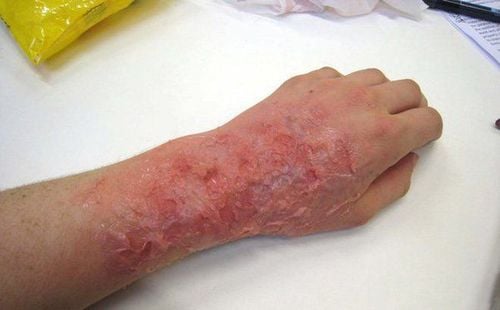This is an automatically translated article.
The article was professionally consulted by Specialist Doctor II Mai Anh Kha - Orthopedic surgeon - Department of General Surgery - Vinmec Danang International General Hospital.Traumatic shock needs to be recognized for timely and appropriate treatment, because traumatic shock can cause respiratory and circulatory failure quickly and endanger the patient's life.
1. What is traumatic shock?
Traumatic shock is a condition in which all the organs and functions of the body, especially the respiratory and circulatory systems, are completely collapsed, affecting the function and functioning of other organs (due to traumatic shock). lack of oxygen).There are many causes of traumatic shock, such as accidents at work, traffic. In the past, traumatic shock caused by war.
2. Signs and stages of traumatic shock over time appear
Based on the time of appearance, traumatic shock is divided into 2 stages: primary shock and secondary shock, with specific signs as follows.2.1 Signs of traumatic shock - Stage of primary shock
The first stage of traumatic shock, also known as primary shock, can occur 10 to 15 minutes after the injury.Awake but in a state of excitement and struggle. Excessive sweating Pale or reddened skin Increased pupillary reflexes Maximum and minimum increase in blood pressure. Breathing rate can increase to 25-30 times/minute. Body temperature remains constant, or may increase or decrease.

Huyết áp tăng là triệu chứng của sốc tiên phát
2.2 Signs of traumatic shock - Stage of secondary shock
The primary shock phase is followed by secondary shock, however, in some cases it can occur immediately after the trauma.Blood pressure drops or not measured, difficult to catch. Body temperature drops, especially in the bridge of the nose, pale skin. Immobility, lethargy, decreased sensation in the body. Capillary disorders with signs of skin not rosy when impacted on people. Patients may experience mild shock (blood pressure 80-100 mmHg) or moderate (blood pressure 40-80 mmHg) to severe (blood pressure less than 40 mmHg).
3. Signs and stages of traumatic shock according to clinical course
Based on clinical development, traumatic shock is divided into 2 stages, including: erectile shock and debilitating shock.3.1 Signs of traumatic shock - Stage of erectile shock
The stage of erectile shock usually occurs about 10 - 30 minutes after the injury with the signs of each specific phase as follows:Increased stimulus response, reflexes, muscle tone and sensation. Struggling, talking a lot and complaining of pain while awake. Normal or rapid pulse. Increased blood pressure (range 140/90 - 200/140 mmHg). Body temperature may be normal, or increase, or decrease. Breathe quickly and deeply (about 20-30 times/minute).
3.2 Signs of traumatic shock - Stage of debilitating shock
When the hypoxia due to blood loss in the erectile shock stage is increasing, the patient enters the stage of asthenic shock, the whole function is completely collapsed. At this stage, if not treated promptly and appropriately, it can lead to death. Depending on blood pressure, this stage of traumatic shock is divided into 3 specific levels as follows:Mild shock: Blood pressure is measured in the range of 90-100 mmHg. The central nervous system is mildly inhibited, reflexes are reduced. Moderate shock: Blood pressure is measured in the range of 80-90 mmHg, pulse is between 110-120 times/minute, breathing is shallow, skin is pale. The central nervous system is inhibited. Severe shock: Blood pressure measured in the range of 60 - 70 mmHg, pulse over 120 times/minute, pale skin. The central nervous system is severely inhibited, the patient is lethargic. Very severe and severe shock: Signs of very severe traumatic shock manifest in the following 3 stages: Pre-dying: Impaired consciousness, unmeasured blood pressure, rapid breathing, shallow breathing. Dying: Loss of consciousness, can't catch pulse and blood pressure, patient has severe respiratory disorders, breathing yawn. Clinical death: The heart stops beating, the patient stops breathing for about 5 minutes. This stage, if not treated in time, can turn to the death stage of the organism.

Giai đoạn sốc nhược rất nguy hiểm có thể gây chết lâm sàng
4. Signs of escape from traumatic shock
Traumatic shock is a condition in which the body is severely injured, develops suddenly and can get worse if not treated promptly. Depending on the cause and appropriate treatment, traumatic shock may or may not be reversible. Signs of exiting traumatic shock are as follows:The patient is awake. The skin is ruddy again. Body temperature is back in the extremities and bridge of the nose Normal blood pressure, heart, and pulse Breathe deeply and evenly Volume of water Normal urine output (about 60 ml/hour) Measurements are stable for 2 - 3 hours Traumatic shock often occurs in cases such as traffic accidents. Recognizing the signs and stages of traumatic shock will help patients receive emergency treatment and timely treatment.
With more than 22 years of professional experience, Doctor Mai Anh Kha used to hold the position of Head and Deputy of Department of Surgery - Plastic Burns at Hue Central Hospital and worked at other large medical units such as Da Nang Hospital, Traffic Hospital 5. Currently, he is an Orthopedic Surgery Doctor - General Surgery Department - Vinmec International General Hospital Da Nang.
To register for examination and treatment at Vinmec International General Hospital, you can contact Vinmec Health System nationwide, or register online HERE.














